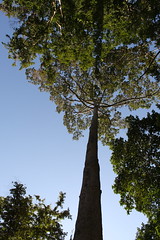What is Asian Mahogany Hardwood Flooring?
Botanical Name: Dipterocarpus spp
Fast Facts
Color: The heartwood of Asian mahogany is usually a reddish brown, although some variations are expected because of the many varieties. These variations can range from a deep pink to a purplish red. The sapwood of the Asian mahogany is lighter and may have grey or yellow tint.
Grain: The grain of Asian mahogany is usually straight but may have a slight wave.
Variations within Species and Grades: With more than seventy varieties of Asian mahogany, there are some variations but not that are overly noticeable after processing.
Hardness/Janka: With more than seventy varieties of Asian mahogany, there are some variations but not that are overly noticeable after processing.
Sawing/Machining: With more than seventy varieties of Asian mahogany, there are some variations but not that are overly noticeable after processing.
Sanding: Pieces with a high density of resin can be more difficult to sand.
Nailing: No known problems with nailing.
Finishing: Asian mahogany that has a lot of resin is very difficult to finish, timber with less resin is much easier to finish.
Availability: Somewhat limited availability.
Credit: University of Tasmania
Asian Mahogany, or Keruing, is made up of about 70 species of the Dipterocarpus genus. These large hardwoods can grow to heights of 230 feet. The various species are found throughout the eastern hemisphere in areas such as the Philippines, Pakistan, India, Thailand, and Sri Lanka. Asian mahogany trees can reach heights of up to 200 feet when fully mature with diameters of up to six feet.
History
Asian mahogany is common throughout Malaysia which is why the common name of the wood, Keruing, is of Malaysian origin. It is found mostly in lowland forest but may also be found in some hilltop forests.
Durability
Asian mahogany is relatively durable but should only be used in flooring that will be inside and away from the elements.
Workability
It can be difficult to machine Asian mahogany due to the high resin content of some pieces of lumber. Keeping all cutting edges sharpened can help make it a bit more manageable. Additionally, it can be difficult to season and dry.
Where to use
The moderate durability makes Asian mahogany a good choice for flooring. As with other hardwood options, it is important that the flooring is not placed in an area that will be exposed to excessive moisture or standing water.
Care and Maintenance
Proper care and maintenance will ensure a long life for this beautiful hardwood flooring. Runners or rugs should be placed in areas that will receive high foot traffic such as entryways and hallways. Pads need to be placed beneath the legs of furniture to prevent gouges. Routine sweeping or vacuuming, on a hardwood setting, can remove sand and grit that might otherwise scour the finish of the flooring making it more susceptible to wear.
Environmental Issues
Keruing, or Asian mahogany, is still widely available throughout the areas in which it naturally occurs. Because of this it is not listed as endangered or even threatened. However, nations in which this tree grows have been urged to encourage conservation as the timber becomes more popular.


Robert Pollock
I’m looking for wood to put as a 3′ wide walk-way around part of our pool. I’ve built many things over the years and normally, for outdoor use only pressure treated or certain types of wood such as cedar would be used but now I’m in Palm Springs, CA and the sun here is so intense, that most people don’t bother with wood outside, or they try to use it and it suffers and looks it. It fades, checks and cracks and gets brittle. I doubt the 3″ of rain annually has any effects, just the sun.
My experience tells me only one thing protects wood from sunlight and that is pigmentation, so treating any wood for outdoor use around here must have some.
Investigation tells me that the newer poly based stains can be cut up to 50% with plain old mineral spirits, which helps to deliver the pigment a little deeper than just superficial and begins a maintenance regimen I’ve been using on Redwood outdoor bench exposed to lots of sun for 3 years now, which is simply to wash and scrub once a year, and re-apply. More coats the better, like six, ten or more over the years.
Now, I know that boat builders use Oak and Mahogony so I want to try my finishing/preservation on a domestic species, namely Oak flooring. I will rip the boards square and install with 1/4″ spaces, carefully fastened to a pressure treated frame with a secure and aesthetic screwing system. So, what do you have that’s Oak, mid-width and comes in longer lengths? I could get by with a minimum length of 12″ but the longer the better. —-Robert, and thanks for your time and trouble. It’s a $1000 experiment to see if we should be re-thinking (the) use of wood, outdoors in the desert.
ivantee
As I’m using on highly termite (white ants) risk area, could this Keruing wood repelled from the attack of the termite and wood borer if used in structure ?
Thanks
Ivan Tee
ivantee
Want to know more good and bad comment about this wood , as it was used on flooring and container floor board as where as decking, is the water adsorbing rate is very high? Normally what type of stain or finished is the best result and durable for flooring ( indoor) and out door decking? and also how about the price of premium grade price of such solid floor board per m2 or per ton w/o installation and after installation?
Thank you and regards.